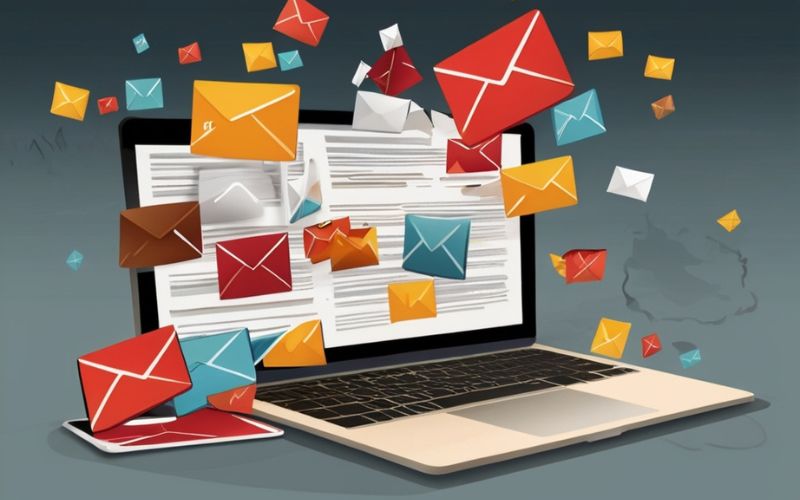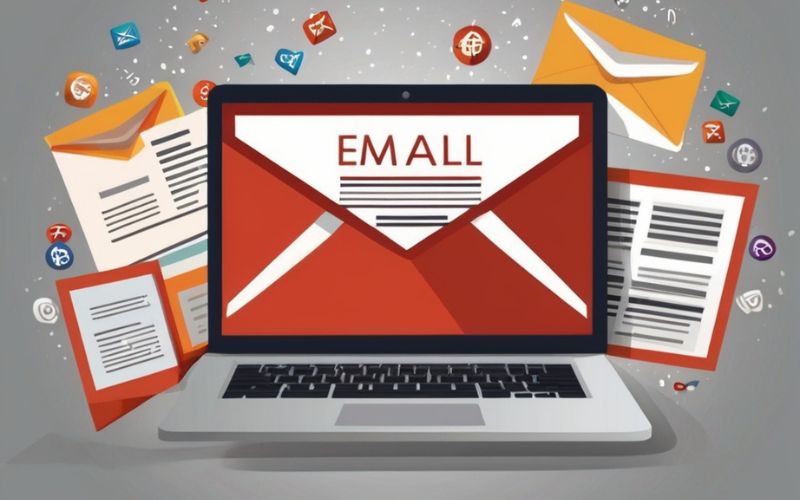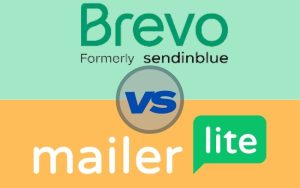In the realm of digital marketing, harnessing the power of email can be a game-changer for online businesses. Email marketing, a strategic approach to reaching and engaging a target audience via electronic mail, has become an indispensable tool for businesses seeking to establish lasting connections with their clientele.
Table of Contents
What is Email Marketing and Why Is It Important?
Email marketing involves sending targeted messages to a group of people through email, with the aim of promoting products, services, or fostering relationships. For online businesses, it’s a lifeline that facilitates direct communication with potential and existing customers. The importance lies in its ability to deliver personalized content, nurture leads, and drive customer engagement.

Benefits of Email Marketing: Building Trust, Boosting Conversions, and Generating Leads
The benefits of a well-executed email marketing strategy are manifold. Firstly, it serves as a trust-building mechanism, allowing businesses to establish credibility and reliability in the eyes of their audience. Secondly, it’s a potent tool for increasing conversions – turning interested prospects into paying customers. Lastly, it’s a robust lead generation method, enabling businesses to expand their customer base and drive sustained growth.
Main Purpose of This Article: Unveiling the Top 5 Email Marketing Mistakes
Now, let’s zoom in on the primary objective of this article: to empower readers with insights into the ‘Top 5 Email Marketing Mistakes To Avoid.’ In the ever-evolving landscape of digital communication, these pitfalls can potentially hinder the success of your email campaigns and undermine the desired results.
- Neglecting Audience Segmentation: Failing to tailor your messages to specific audience segments can lead to disengagement and decreased effectiveness.
- Overlooking Personalization: Lack of personalization can make your emails feel generic, diminishing the connection with your audience.
- Ignoring Testing and Optimization: A failure to conduct A/B tests and optimize campaigns based on analytics can result in missed opportunities for improvement.
- Neglecting Mobile Responsiveness: In an era where mobile usage is prevalent, neglecting the mobile-friendliness of your emails can alienate a significant portion of your audience.
- Disregarding Analytics and Metrics: Ignoring the valuable insights provided by metrics can prevent you from refining your strategy and achieving optimal results.
As we navigate the nuances of email marketing, it’s essential to recognize and sidestep these common pitfalls. By doing so, you position yourself to harness the full potential of email campaigns, fostering stronger connections with your audience and driving the success of your online business. Join us in this exploration of email marketing mastery, and let’s propel your campaigns to new heights.
Mistake #1: Not Having a Clear Goal in Email Marketing
When diving into the expansive realm of email marketing, the foremost blunder to avoid is the lack of a clear goal. In the context of ‘Top 5 Email Marketing Mistakes To Avoid,’ not defining a clear objective for your email campaigns can significantly impede your success. Let’s dissect why having a clear goal is paramount and how it aligns with effective email marketing strategy.
Understanding the Importance of a Clear Goal
In the pursuit of mastering email marketing, envisioning a clear goal acts as your guiding light. Without a defined objective, your campaigns may lack direction and fail to resonate with your audience. Whether it’s boosting open rates, increasing click-through rates, or driving sales, a clear goal sets the stage for a purposeful and result-oriented email marketing strategy.
Examples of SMART Goals for Email Marketing
To illustrate, let’s delve into Specific, Measurable, Achievable, Relevant, and Time-bound (SMART) goals for email marketing:
- Increase Open Rates by 20% within the Next Quarter: A specific goal targeting open rates that is measurable, achievable, relevant, and time-bound.
- Enhance Click-Through Rates on Product Links by 15% in the Next Two Months: This SMART goal focuses on a specific action (click-through rates), is measurable, achievable, relevant, and time-bound.
- Achieve a 10% Growth in Sales from Email Campaigns by Year-End: A goal that ties directly to revenue, ensuring it is specific, measurable, achievable, relevant, and time-bound.
Tips for Setting and Measuring Email Marketing Goals (H3: Goal Setting Tips)
To set and measure these goals effectively, consider the following tips:
- Utilize Analytics Tools (Secondary Keyword: Email Marketing): Leverage robust analytics tools to track and analyze key metrics. Platforms like Google Analytics and specialized email marketing tools provide insights into open rates, click-through rates, and overall campaign performance.
- A/B Testing (Secondary Keyword: Email Marketing Strategy): Experiment with A/B testing to fine-tune your campaigns. Test different subject lines, content formats, and call-to-action buttons to identify what resonates best with your audience.
- Implement Surveys: Gain direct feedback from your audience through surveys. Understand their preferences, expectations, and satisfaction levels to refine your email marketing strategy.
By integrating these tips into your email marketing approach, you not only avoid the critical mistake of lacking a clear goal but also ensure that your goals are strategic, measurable, and aligned with the overarching objective of enhancing your email marketing prowess.
In the subsequent sections, we will uncover more crucial mistakes to avoid, providing actionable insights to propel your email marketing strategy to new heights. Stay tuned to Dinalex Review for a comprehensive guide to steering clear of the ‘Top 5 Email Marketing Mistakes.’
Mistake #2: Sending Emails to the Wrong Audience
In the realm of email marketing, precision is paramount, and Mistake #2, Sending Emails to the Wrong Audience, stands as a formidable barrier to success. Let’s unravel the intricacies of this common blunder and explore why it can be detrimental to your email marketing performance.
Understanding the Wrong Audience:
The ‘wrong audience’ refers to recipients who are not aligned with the intended target demographic, behavior, interests, or preferences for a particular email campaign. When messages miss the mark and land in the inboxes of disinterested or irrelevant individuals, it not only leads to disengagement but also tarnishes sender reputation and can trigger spam complaints.
Impact on Email Marketing Performance:
Sending emails to the wrong audience adversely affects crucial metrics such as open rates, click-through rates, and ultimately, conversions. It dilutes the effectiveness of your message, as it fails to resonate with the genuine interests and needs of the recipients. This misalignment can result in increased unsubscribe rates, harming your email deliverability and overall campaign success.
Segmentation Strategies for Targeting the Right Audience:
To rectify this mistake, savvy marketers employ segmentation strategies, tailoring their messages to specific audience segments. Here are some examples of effective segmentation techniques:
Demographics: Divide your audience based on age, gender, location, or other demographic factors.
Behavioral Segmentation: Analyze user behavior, such as previous purchases or interactions with your emails, to create targeted campaigns.
Interests and Preferences: Leverage data on subscribers’ preferences and interests to deliver content that resonates with their specific tastes.
Tips for Collecting and Updating Subscriber Data:
To ensure you are consistently targeting the right audience, proactive data collection and updates are essential. Incorporate the following tips into your email marketing strategy:
Opt-in Forms: Implement user-friendly opt-in forms on your website and landing pages, encouraging visitors to subscribe and explicitly express their interest.
Landing Pages: Design dedicated landing pages that capture specific information about your audience, allowing for more accurate segmentation.
Feedback Forms: Collect feedback from subscribers to understand their evolving preferences and expectations. Use this data to refine your targeting strategies over time.
Incorporating Secondary Keywords:
In the realm of email marketing, steering clear of common email marketing mistakes is paramount. By avoiding Mistake #2 and optimizing your strategy for the right audience, you enhance your overall email marketing performance and contribute to the success of your campaigns.
Mistake #3: Writing Boring or Spammy Subject Lines – The Unsung Heroes of Email Marketing
In the intricate realm of email marketing, Mistake #3 is a silent saboteur: Writing Boring or Spammy Subject Lines. Your subject line is the first impression, the make-or-break moment that determines whether your email gets opened or lands in the dreaded spam folder. Let’s dissect the significance of subject lines and explore how to wield them effectively.
What is a Subject Line and Why is it Crucial for Email Marketing?
A subject line is the concise, attention-grabbing phrase that serves as the gateway to your email content. It acts as a teaser, enticing recipients to open and engage with your message. A compelling subject line is crucial because it directly impacts your email’s open rate – a metric that holds immense weight in the success of your email marketing campaigns.
Examples of Good and Bad Subject Lines:
Bad Example:
“Special Offer Inside”
Why it’s Ineffective:
Vague and lacking specificity, this subject line fails to generate curiosity or convey value, making it likely to be overlooked or dismissed as spam.
Good Example:
“Unlock Exclusive Discounts – Limited Time Only for Email Marketing Enthusiasts!”
Why it’s Effective:
This subject line combines personalization (“for Email Marketing Enthusiasts”) with urgency (“Limited Time Only”) and a clear benefit (“Unlock Exclusive Discounts”), making it compelling and likely to capture attention.
Tips for Writing Catchy and Relevant Subject Lines:
- Use Power Words: Incorporate impactful words that evoke emotion or curiosity. For instance, words like “exclusive,” “limited,” or “uncover” can add a sense of urgency and importance.
- Personalization Matters: Tailor subject lines to resonate with your audience. Mentioning ’email marketing for beginners’ or incorporating the recipient’s name can create a personalized connection.
- Inject Urgency: Create a sense of urgency by highlighting limited-time offers or exclusive opportunities. Phrases like “Act Now” or “Limited Slots Available” can prompt quick action.
- Curiosity is Key: Craft subject lines that pique curiosity without giving away too much. Tease the content inside, prompting recipients to open the email to satisfy their curiosity.
Tying it All Together:
In the world of ‘Top 5 Email Marketing Mistakes,’ neglecting the potency of subject lines can significantly hinder your campaign’s success. By mastering the art of crafting captivating subject lines, infused with personalization, urgency, and curiosity, you can elevate your open rates and ensure your emails stand out in crowded inboxes. Remember, your subject line is the ambassador of your email – make it count.
Mistake #4: Sending Too Many or Too Few Emails – Striking the Optimal Balance for Email Marketing Success
In the intricate world of email marketing, finding the sweet spot in email frequency is a pivotal aspect that can significantly impact the success of your campaigns. Let’s unravel the mystery behind Mistake #4 and explore why striking the optimal balance is crucial for maximizing engagement and conversion rates.
The Optimal Email Frequency:
Determining the ideal frequency of your email campaigns requires a nuanced understanding of your audience and industry. There’s no one-size-fits-all solution, but finding the right balance is paramount. Too many emails can lead to subscriber fatigue and increased unsubscribe rates, while too few emails may result in a loss of engagement and relevance.
Examples of Finding the Right Balance:
- Industry Benchmarks (Secondary Keyword: Email Marketing):
- Research industry benchmarks to understand the typical email frequency within your sector.
- Analyze competitors’ strategies to identify trends and align your email frequency accordingly.
- Subscriber Preferences (Secondary Keyword: Top Email Marketing Mistakes):
- Leverage preference centers to allow subscribers to choose their preferred email frequency.
- Conduct surveys or gather feedback to understand the ideal balance that resonates with your audience.
- Engagement Metrics:
- Monitor engagement metrics such as open rates, click-through rates, and conversion rates.
- Adjust email frequency based on the performance of previous campaigns to optimize for maximum impact.
Tips for Scheduling and Automating Email Campaigns:
- Utilize Email Marketing Software (Secondary Keyword: Email Marketing):
- Invest in robust email marketing software that offers scheduling and automation features.
- Leverage tools that allow you to set specific delivery times and automate campaigns based on user behavior.
- Create a Content Calendar:
- Develop a content calendar to plan your email campaigns in advance.
- Ensure a balanced distribution of content, promotions, and updates throughout the month to maintain engagement without overwhelming subscribers.
- Implement Triggers (Secondary Keyword: Top Email Marketing Mistakes):
- Set up triggers based on subscriber actions, such as website visits or previous interactions.
- Automate follow-up emails or targeted campaigns to capitalize on user engagement and enhance the relevance of your messages.
Strive for Harmony in Email Frequency for Optimal Results
Mistake #4 highlights the critical importance of achieving harmony in your email frequency. By leveraging industry benchmarks, understanding subscriber preferences, and closely monitoring engagement metrics, you can fine-tune your approach. Utilize email marketing software, content calendars, and triggers to schedule and automate campaigns effectively, ensuring that your messages strike the right chord with your audience. Stay tuned for more insights into the ‘Top 5 Email Marketing Mistakes’ as we navigate the intricate landscape of email marketing success.
Mistake #5: Ignoring Mobile Optimization in Email Marketing
In the dynamic landscape of email marketing, Mistake #5 stands out prominently: Ignoring Mobile Optimization. As we delve into this crucial aspect, it’s essential to understand what mobile optimization is and why it plays a pivotal role in the success of your email campaigns.
What is Mobile Optimization in Email Marketing?
Mobile optimization involves tailoring your email content and design to ensure an optimal viewing and interaction experience on mobile devices. With the increasing prevalence of smartphones, a significant portion of your audience accesses emails through mobile devices. Neglecting mobile optimization can lead to distorted layouts, slow loading times, and frustrated recipients, ultimately diminishing the effectiveness of your email campaigns.
Why is Mobile Optimization Vital for Email Marketing?
Widespread Mobile Usage: A substantial percentage of email opens occur on mobile devices. Ignoring this audience segment means missing out on valuable engagement opportunities.
User Experience: Mobile-optimized emails enhance the overall user experience, fostering positive interactions with your brand. A seamless, visually appealing experience encourages recipients to engage with your content and take desired actions.
Search Engine Ranking: Search engines prioritize mobile-friendly content. By optimizing your emails for mobile devices, you not only cater to user preferences but also enhance your chances of ranking higher in search engine results, indirectly benefiting your email marketing strategy.
Examples of Mobile Optimization Techniques:
Responsive Design: Craft emails using responsive design principles, ensuring they adapt seamlessly to different screen sizes. This guarantees a consistent and visually appealing layout across various devices.
Concise Content: Optimize email content for brevity and clarity. Mobile users often have limited attention spans, so conveying your message concisely improves readability and engagement.
Clear Call-to-Action (CTA): Create easily clickable buttons with concise and compelling CTAs. Ensure they are large enough to tap comfortably on smaller screens, promoting user interaction.
Tips for Testing and Improving Mobile Email Performance:
Mobile-Friendly Templates: Utilize email marketing platforms that offer mobile-friendly templates. These templates are designed to automatically adjust to different screen sizes, simplifying the mobile optimization process.
Testing Tools: Leverage email testing tools that simulate how your emails appear on various devices. Identify and rectify any issues related to layout, font size, or image rendering that may affect the mobile user experience.
User Feedback: Encourage recipients to provide feedback on their mobile experience. Analyze this feedback to identify areas for improvement and to align your mobile optimization strategy with user preferences.
In summary, mobile optimization is not just a recommendation but a necessity in the realm of email marketing. By addressing Mistake #5 and optimizing your emails for mobile devices, you position your campaigns for success, catering to the diverse preferences of your audience and maximizing the impact of your email marketing efforts. Don’t let this common email marketing mistake hinder your campaign’s potential; embrace mobile optimization for unparalleled success.
Conclusion
In conclusion, mastering the art of email marketing hinges on steering clear of the ‘Top 5 Email Marketing Mistakes.’ Let’s recap the key insights that can transform your campaigns and supercharge your results:
- Segmentation is Key: Tailor your messages with precision by embracing the power of list segmentation.
- Personalization Matters: Forge stronger connections with your audience through effective email personalization strategies.
- Test and Optimize: A/B testing is your ally in refining campaigns, ensuring they resonate with your audience and drive superior results.
- Mobile Optimization is Non-Negotiable: Ignoring the mobile audience is a costly oversight. Optimize your emails for seamless viewing across all devices.
- Harness Analytics: Dive into the metrics to glean invaluable insights, steering your strategy toward continuous improvement.
Benefits of Mastery:
By avoiding these common pitfalls, you’re not just preventing errors; you’re unlocking the full potential of your email marketing endeavors. Experience heightened engagement, improved conversion rates, and a stronger connection with your audience.
Take the Next Step!
Ready to revolutionize your email marketing strategy? Visit our website for in-depth guides, expert reviews, and the latest insights to keep you ahead of the curve. Sign up for our newsletter to receive exclusive tips and updates directly to your inbox.

Thank You for Your Time!
We appreciate you investing your time in exploring the intricacies of email marketing with us. Your success is our priority. Share your thoughts by leaving a comment, and don’t forget to spread the knowledge by sharing this article with your network.





